An Autumn Day Tour in North Norfolk today. It was a very windy day, as Storm Ali swept across the country, with gusts touching as high as 52mph at one point. Thankfully we avoided the worst of the storm as it hit further north in the country and it remained dry and even sunny at times here. It is remarkable what you can see, whatever the weather – so we went out as normal and had a great day.
When we arrived at Titchwell, there were not too many cars in the car park yet. A flock of Long-tailed Tits appeared in the trees next to where we parked and we watched several up in a sycamore, before they flew off across the car park, along with several Great Tits and Blue Tits. We had a quick look around the overflow car park but despite the fact that there were no cars here yet, the bushes were quite quiet in the wind.
A Goldcrest was singing from deep in the sallows by the path to the visitor centre and we could hear a Chiffchaff calling too. We stopped to look at the feeders and were surprised to see a juvenile Great Spotted Woodpecker hanging on the side of one of them. Not a bird we see on the feeders here very often!
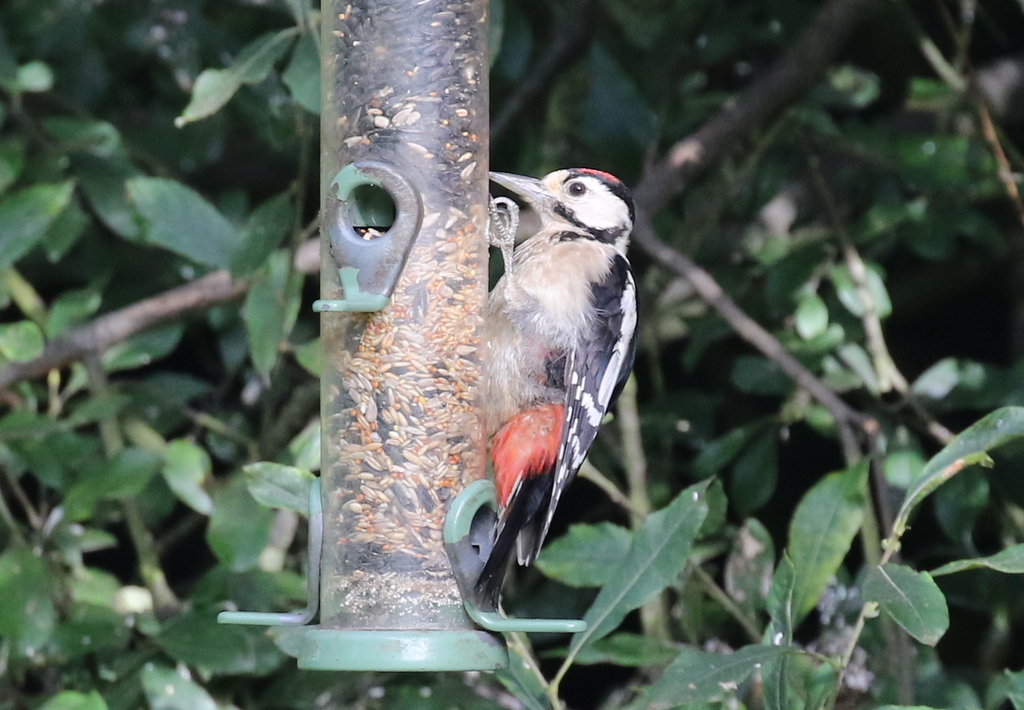
We thought we would have a look round at Patsy’s Reedbed first this morning. There were lots of ducks out on the water, and it didn’t take long to find the two female Red-crested Pochard which have been hanging out here in recent weeks. There were also a good number of Common Pochard on here, and one or two Tufted Ducks.

The dabbling ducks were mainly Gadwall and many of the drakes are already well advanced in their moult back out from drab eclipse plumage. Otherwise, there were a few Mallard, a small number of Shoveler and one or two Teal. We heard a Little Grebe laughing (at us?) and two of them swam out of the reeds just across the water from us.
Despite the wind, there appeared to be a steady trickle of hirundines on the move. While we stood at the screen here we saw several small groups of Swallows and House Martins battling into the wind before continuing west over the trees. They are on their long journey down to Africa for the winter now – a real sign of autumn! A couple of Marsh Harriers were hanging in the breeze out over the reedbed.
The Autumn Trail is open at this time of year, so we set off to walk round to the back of the Freshmarsh. A Bloody-nosed Beetle was walking across the gravel on the edge of the path and we stopped for a closer look. We also saw several squashed ones, a hazard for the beetles crossing at this time of year, and a Devil’s Coach-horse too.
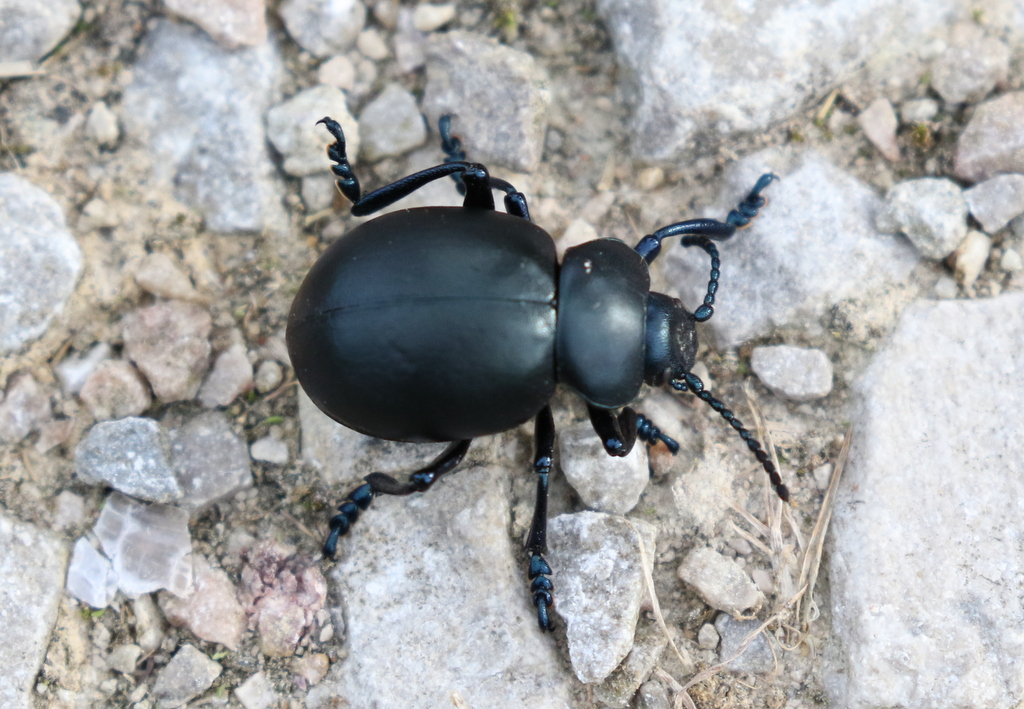
There were no waders on the mud at the back corner of the Freshmarsh today, just a couple of Moorhens in the edge of the reeds and several more Teal. Not surprisingly, the reeds were quiet too – everything was keeping tucked well down today, out of the wind. We decided to walk back round via Meadow Trail and out along the main path.
With all the diving ducks on Patsy’s at the moment, there were just a couple of Little Grebes and a Coot on the reedbed pool, so we continued straight on to Island Hide where we could also get some shelter. The strong wind blows the water away from the bank towards the back of the Freshmarsh, so there was a large expanse of drier mud in front of the hide today.
Several Teal were feeding in a small watery channel just below the hide, including a drake already moulting back out of eclipse plumage and starting to show its smart breeding plumage head pattern. Most of the other ducks were huddled in groups around the islands asleep, but checking through them carefully we found a single Pintail in with the Shovelers.

There were lots of waders on here again today. Plenty of Ruff, feeding out on the wetter mud along the edges of the water. A large flock of small waders kept flying up and whirling round, before landing back down on the mud somewhere different. They were very nervous today in the wind. When they settled, we could look through them. They were mostly Dunlin, juveniles with black-streaked bellies, but in with them was a single juvenile Curlew Sandpiper and three Ringed Plovers.
We got the scope on the Curlew Sandpiper and had a closer look at it. Alongside the Dunlin, it was clearly a touch larger and slimmer, with a clean white belly and orangey-buff wash on the breast. It’s bill was noticeably long and downcurved. Amazing to think that it was raised just a few weeks ago up in central Siberia and is now making its way down to Africa, with no guidance from its parents!

There were lots of godwits roosting out around the islands too. Mostly Black-tailed Godwits, but on closer inspection we could see there were quite a few Bar-tailed Godwits in with them and several Knot hiding in amongst there legs. We had a nice scope view of all three species together, giving us a nice comparison between the two godwit species in particular.
A single Turnstone appeared on the island nearby and a lone Golden Plover was resting on its belly on the mud too. There are still a few Avocets left here, even if most have now left for the winter, and they were feeding or roosting around the back of the small island further back.
Continuing on along the main path, we had a closer view of the Curlew Sandpiper on the mud before all the birds flew again. The Volunteer Marsh was quiet, with most of the mud quite dry at the moment, although there were a few Black-tailed Godwits down in the deep channel which runs back at the far end.
It was quite exposed out from the shelter of the bank. We could see lots of Oystercatchers roosting on the grassy island on the Tidal Pools and there were several Grey Plover here too, but it was hard to keep the scope steady out here in the wind. We continued on to the beach.
The sea was on its way in and had already covered the mussel beds. It was very choppy, but sheltering behind the dunes, we scanned across and managed to find two drake Eiders out on the water. A couple of Sandwich Terns flew past. A small group of Oystercatchers came in up the beach but a single Bar-tailed Godwit found it more of a struggle, flying away to the east before battling in upwind. A single Golden Plover trying to fly west along the shoreline may have been a migrant arriving.
It was harder going, walking back into the wind, so we took a detour into Parrinder Hide for a rest. The main feature now was the number of gulls which had come in to the Freshmarsh since we had looked earlier, presumably escaping the wind out on the beach. They were mostly Black-headed Gulls but looking through them carefully we found a single Mediterranean Gull, a 1st winter with a black bandit mask. Scanning through the Herring Gulls and Lesser Black-backed Gulls we found an adult Yellow-legged Gull, its mantle a shade darker than a Herring Gull, but with yellow rather than pink legs.
It was lunchtime and those who hadn’t brought their lunch with them and sneaked a quick sandwich in the hide were getting hungry! We made our way quickly back to the picnic area, which was sheltered from the wind and in the sunshine. The dragonflies appreciated it here too – there were lots of Migrant Hawkers buzzing around the trees and at least 15 Common Darters basking on a single bench next to us.
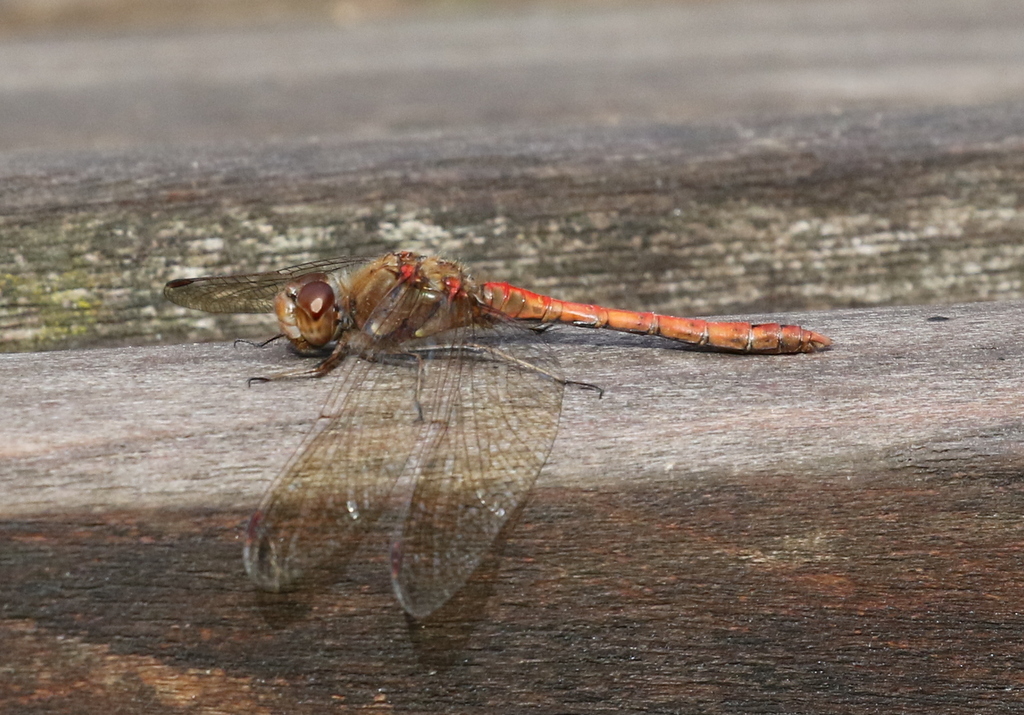
After lunch, we made our way back east along the coast road. From the car, we picked up a couple of Red Kites on the way, one tussling with a Marsh Harrier. We parked just beyond Stiffkey and made our way down along the path to the Fen. A Kestrel was struggling to balance on top of a hawthorn bush out in the meadows as we passed.
The bushes along the footpath were uncharacteristically quiet – possibly due to the wind today. When we got to the point where you can see over the brambles, we immediately spotted the long line of white shapes in the vegetation on the island. Spoonbills – and, as usual, they were mostly asleep! One was awake though, busy bathing in the water just beyond, flashing its long yellow-tipped black spoon-shaped bill.
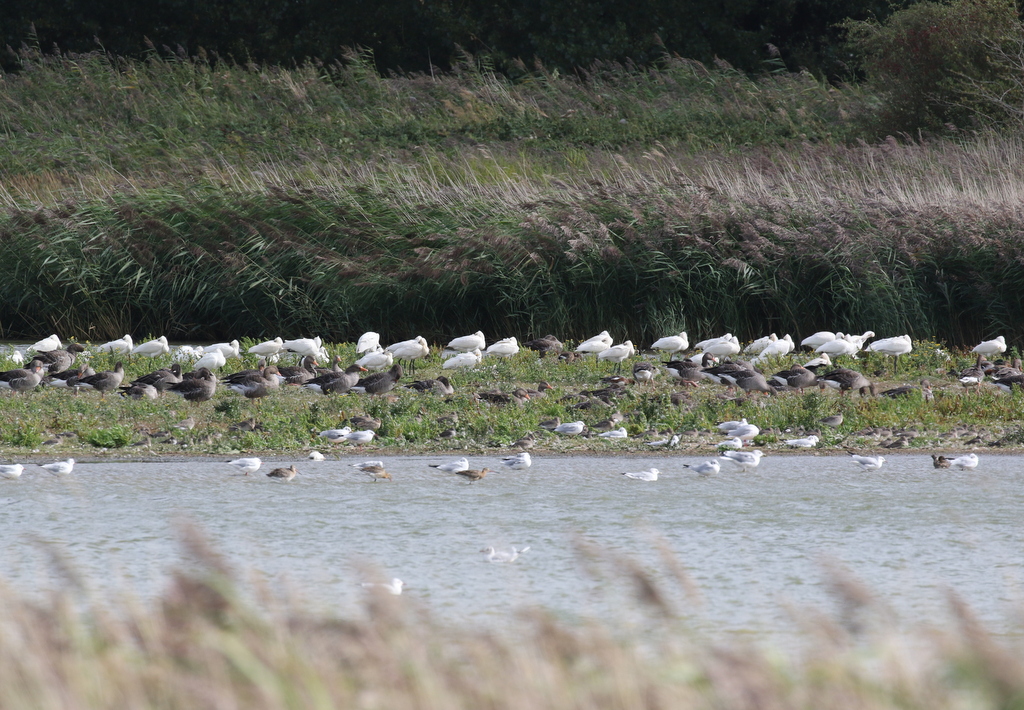
It was nice and sheltered here, and in the sun, so we paused a while here to scan the rest of the Fen. There were lots of waders roosting on the island in front of the Spoonbills, lots of Black-tailed Godwits and Ruff. A group of Redshank was bathing in the water in front of the island and with them we could see two Greenshank, slightly larger, slimmer and more elegant, with brighter white underparts. A Green Sandpiper called.
There are lots of ducks on here too now. A group of rusty-coloured Wigeon were roosting in the vegetation on the edge of the channel and several Pintail were busy upending out in the water. Despite the fact that the drakes don’t have the long pin-shaped feathers at this time of year, we could still see their more pointed tails.
It was windy up on the seawall. We had a good look at the Spoonbills through the scope and counted them, 39 in all today, an impressive sight. We could see the Green Sandpiper along the edge at the back and we found a Common Snipe down in front of the reeds. From further along, we could see more Greenshank roosting along the far side.
Continuing on down to the corner overlooking Blakeney Harbour, we could see all the seals hauled out on the tip of Blakeney Point. A couple of Sandwich Terns flew back and forth over the water and we could see a young Gannet plunge diving into the sea beyond the sand bank. A summer-plumaged Red-throated Diver was swimming out in the deeper water of the harbour, but it was hard to see the red on its throat from here.
It was already high tide, but the water had not risen as far as expected in the harbour today, presumably held back by the wind. The waders were still all scattered over the remaining mud, feeding. We found a large group of Grey Plover, including several still mostly in breeding plumage with black faces and bellies. There were lots of Oystercatchers out here too.
It was time to start making our way back, but we had one last treat in store. As we walked back along the path beside the road, a Marsh Harrier appeared over the hedge in front of us and proceeded to quarter over the flower meadow, hanging in the wind. We had a great view of it, a smart adult male, with pale grey panel in the middle of its wings and pale grey tail.
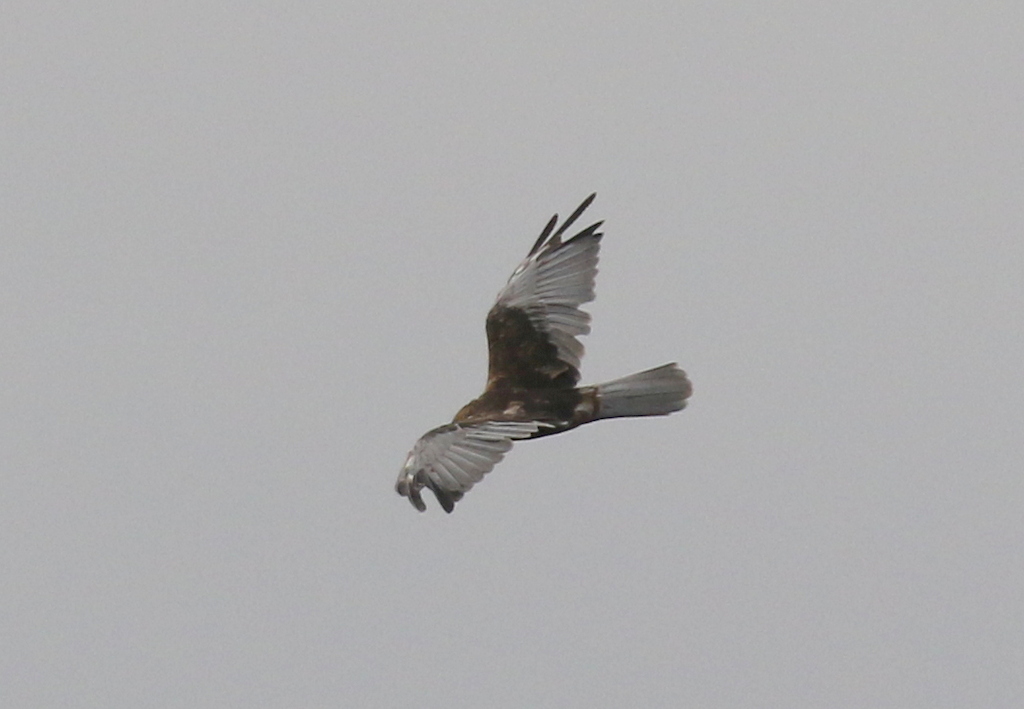
As the Marsh Harrier drifted off, we continued back to the car and then found it again quartering the stubble field next to where we had parked. It was a nice way to end the day. Yes, it had been very windy, but we had enjoyed a great time and still managed to see a good selection of different birds and other wildlife.
















